Converting From One Number System to Another
Converting From Another Base to Decimal:
The
following steps are used to convert a number
in any other base to a base 10(decimal) number:
Step 1: Determine the column (positional)
value of each digit (this depends on the position of the digit and the base of
the number system).
Step 2: Multiply the obtained column values
(in step 1) by the digits in the corresponding columns.
Step 3: Sum up the products calculated in
step 2. The total is the equivalent value in decimal.
Ex 1:
47068=?
10
Step 1: Determine
the column values.
|
Column number (from right) |
Column value |
|
1 |
80 = 1 |
|
2 |
81 = 8 |
|
3 |
82 = 64 |
|
4 |
83 = 512 |
Step 2:
Multiply column values by the corresponding column digits.
|
512 |
64 |
8 |
1 |
|
x 4 |
x 7 |
x 0 |
x 6 |
|
2048 |
448 |
0 |
6 |
Step 3: Sum
up the products
2048 + 448 + 0 + 6 = 2502
Hence, 47068=
250210
Ex 2:
1AC16=?
10
1AC16 =1x162
+ Ax161 + Cx160
=1x256 + 10x16 + 12x1
= 256 + 160 +12
= 42810
Ex 3:
4052 7=?
10
4052 7 = 4x73 + 0x72 +
5x71 + 2x70
= 4x 343 + 0 x 49 + 5x7+ 2x1
= 1372 + 0 + 35 + 2
= 140910
Ex 4:
4052 6=?
10
4052 6 = 4x63 + 0x62 + 5x61
+ 2x60
= 4x216 + 0x36 + 5x6 + 2x1
= 864 + 0 + 30 + 2
= 89610
110014=?
10 (Ans: 32110)
1AC13=?
10 (Ans: 31110)
Converting From Decimal to Another Base (Division Remainder Technique):
The following steps are used to convert a base 10(decimal)
number to a number in another base:
Step 1: Divide the decimal number to be
converted by the value of the new base.
Step 2: Record the remainder from Step 1 as
the rightmost digit (least significant digit) of the new base number.
Step 3: Divide the quotient of the previous
division by the new base.
Step 4: Record the remainder from Step 3 as
the next digit (to the left) of the new base number.
Repeat Steps 3 and 4, recording remainders from right to
left, until the quotient becomes zero in Step 3. Note that the last remainder
thus obtained will be the most
significant digit (MSD) of the new base number.
Converting from a Base Other Than 10 to Another Base Other Than 10:
The following steps are used to convert a number in a base
other than 10, to a number in another base other than 10:
Step 1: Convert the original number to a
decimal number (base 10).
Step 2: Convert the decimal number so
obtained to the new base number.
Examples:
Shortcut Method for Binary to Octal Conversion:
The following steps are used in this method:
Step 1: Divide the digits into groups of
three starting from the right.
Step 2: Convert each group of three binary
digits to one octal digit using the method of binary to decimal conversion.
Examples:
Shortcut Method for Octal to Binary Conversion:
Step 1: Convert each octal digit to a 3
digit binary number (the octal digits may be treated as decimal for this
conversion).
Step 2: Combine all the resulting binary
groups (of 3 digits each) into a single binary number.
Examples:
Shortcut Method for Binary to Hexadecimal Conversion:
Step 1: Divide the binary digits into groups
of four starting from the right.
Step 2: Combine each group of four binary
digits to one hexadecimal digit.
Examples:
Shortcut Method for Hexadecimal to Binary Conversion:
Step 1: Convert the decimal equivalent of
each hexadecimal digit to a 4 digit binary number.
Step 2: Combine all the resulting binary
groups (of 4 digits each) in a single binary number.
Examples:
Fractional Numbers:
In binary number system, fractional numbers are formed in the
same way as in a decimal number system. For example, in decimal number system,
0.235 = (2x10-1) + (3x10-2) + (5x10-3)
and
68.53 = (6x101) + (8x100) + (5x10-1)
+ (3x10-2)
Similarly, in binary number system,
0.101 = (1x2-1) + (0x2-2) + (1x2-3)
and
10.01 = (1x21) + (0x20) + (0x2-1)
+ (1x2-2)
Hence, binary point serves the same purpose as decimal point.
Some positional values in binary number system are given below.
In general, a number in a number system with base ‘b’ would be written as:
an an-1…
a0 . a-1 a-2 … a-m
and would be interpreted to mean:
an x bn
+ an-1 x bn-1 + … + a0 x b0 + a-1
x b-1 + a-2 x b-2 + … + a-m x b-m
The symbols an,
an-1, …, a-m in above representation should be one of
the ‘b’ symbols allowed in the
number system.
Examples:
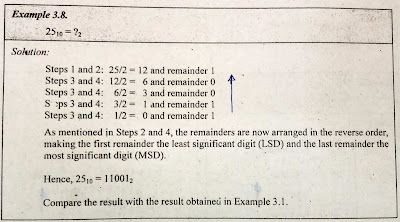

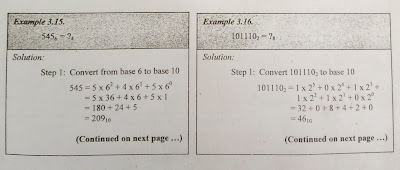
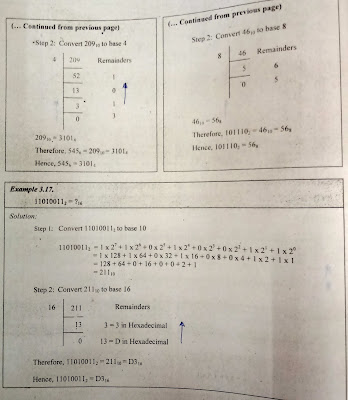
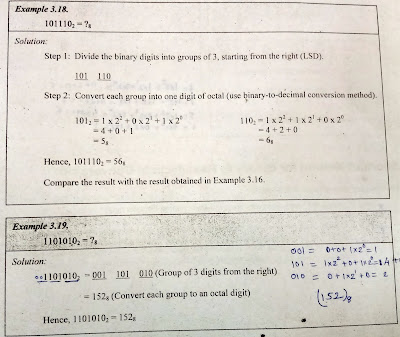
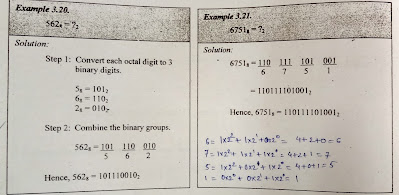
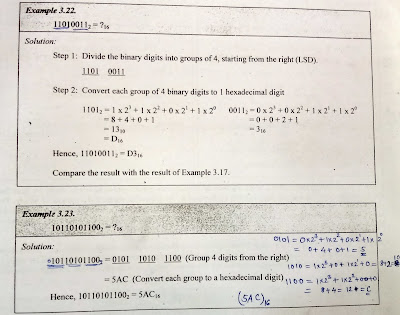



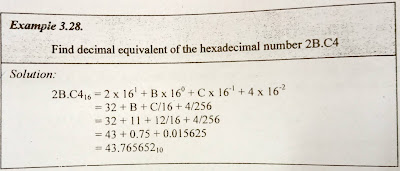
No comments:
Post a Comment